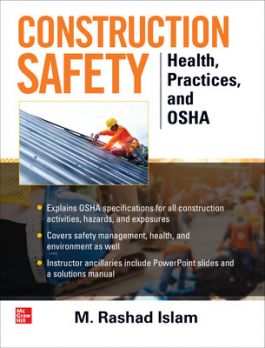
Sometimes you find a gem that you want to keep to yourself but reluctantly agree that the world would be better off if you share its wealth with others. Such was the case when I took SGE training from OSHA back in 1999. The training was given to help prepare compliance officers and a few people from industry to conduct Voluntary Protection Program evaluations at worksites.
During training, students were given a draft of document (book) “Managing Worker Safety and Health” (November 1994) prepared by the OSHA Office of Cooperative Programs. From the moment I began reading I realized this was unlike any other OSHA publication. It was written in plain language and provided clarity on safety management that I found difficult to believe came from the government. Why it remains in draft form is a mystery to me. If I were in control, the document would be rushed off for final publication for everyone’s benefit.
Ever since I received the printed document, I have loaned it to EHS pros and business managers that were having a difficult time envisioning how a safety management program is built from start to finish. My wish was that they, too, would find the information an easy and rewarding read and pass their copy on to others. For all our benefit, we can thank the Missouri Department of Labor and Industrial Relations for graciously placing this document on the Web at http://www.dolir.mo.gov/ls/safetyconsultation/ccp/. The Missouri Division of Labor Standards provides the following introduction:
“The information contained on this Web page and those chapters and appendices referenced below are from a draft OSHA document titledMANAGING WORKER SAFETY AND HEALTH.This information is in the public domain. We have not made any additions or deletions to the text content other than to put it into the html format including the removal of page numbers and the insertion of tags to those old page references so that you may simply click the tag and now go directly to the reference.”

Do-it-yourself download
My objective in writing this article is to provide introductions and a few clips from this OSHA draft for your review in hopes that you will be encouraged to download and read the entire document. I believe the information in the document will be valuable to the novice and even most advanced safety programs.Although the Missouri Department of Labor did not intend to make any changes to the document, there are some minor differences between the print and online versions. I assume these minor differences arose during scanning to translate the print to electronic. Since the document is in the public domain, feel free to correct and make improvements as necessary.
Establishing policy, goals & objectives
I’m often asked what the value of a written safety policy is. Is it just to get your senior manager to place their signature to words you hope they believe? The following is how the OSHA draft introduces the rationale for a written policy:“When you embark on a journey you usually have a reason for going, a destination and a specific plan for reaching your destination. Similarly, when planning a safety and health program, you first decide and put in writing your reason for establishing such a program. This is your policy. Next you decide where you want to end up. This is your goal. Then you map out the path toward your goal, the roads you will take and the vehicles you will use. These are your objectives.”
The OSHA draft explains and provides examples of all the above, again in concise plain language. If you have yet to write a safety policy, I urge you to consider the example of the one OSHA provides. One of the first points where I realized the document swayed from traditional OSHA thinking was in the explanation of setting goals. I still cringe whenever I hear someone say, “Our goal is zero injuries.” I applaud and support the draft’s explanation of setting goals as follows:
“You may want to consider at least two basic types of goals: numerical and descriptive.
Numerical Goal
Numerical goals have the advantage of being easy to measure. However, it is difficult to set a numerical goal that is both attainable and comprehensive enough to serve as destination for your journey.
• If you set a goal, for example, of zero hazards at any time, it may be so difficult to reach that you and your employees will become disillusioned long before you have a chance to reach your destination.
• You could set a goal of a certain number of injuries. In doing so, however, you ignore both illnesses and those existing hazards that have not yet resulted in an injury.
• A goal of a certain number of injuries and illnesses may not be feasible. Illnesses often are difficult to recognize until long after employees’ exposure to hazards that could have been prevented or better controlled. And as with the example above, this goal does not address hazards that have not yet resulted in injury or illness.
Descriptive Goal
No numerical goal can be sufficiently inclusive and still attainable. Therefore, OSHA recommends that you adopt a broad, descriptive safety and health goal: A comprehensive program that assesses all existing and known potential hazards of your worksite and prevents or controls these hazards. Such a goal is neither as succinct nor as easily measurable as a numerical goal. But it is attainable. Further, this goal will be helpful in setting objectives. And it should not be difficult to evaluate objectives and program results against this goal. You may find another way of stating this concept. But OSHA urges you to stay with this basic idea.”


